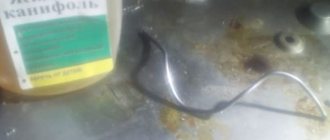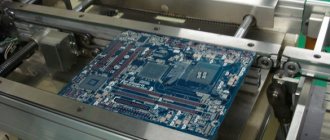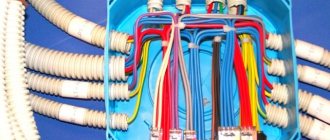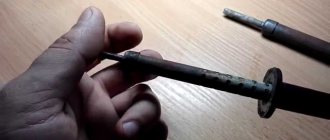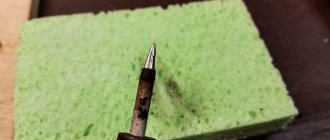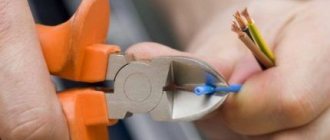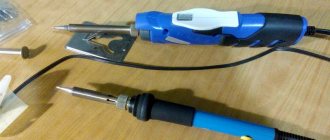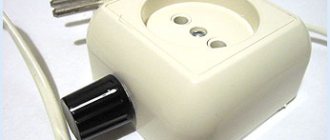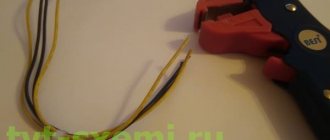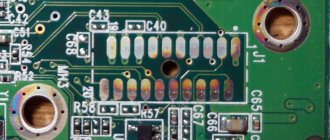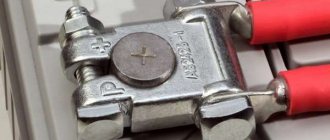What kind of solder to solder
These alloys are made from tin, lead, copper, nickel, or silver. Tin-lead solder (PLS) is used to work with circuit boards and household wiring. Despite the great variety, they can be divided into two types:
- soft (melting point up to 300°C);
- solid (melting point over 300°C).
Any form of release: lump, wire, powder, paste. A universal option is wire up to 2 mm in diameter. It is convenient to put it on the soldering iron tip or insert it directly into the soldering zone.
An interesting offer from manufacturers is solder paste or powder. This is finely dispersed solder, to which liquid flux is added for viscosity. The result is a consistent composition with high adhesion, which can be used for soldering without prior fluxing. We simply apply the paste to the contacts and heat it up.
You can work without a traditional soldering iron, using a soldering iron. Thanks to the fine grinding, the solder melts quickly and instantly spreads over the work area (with the help of flux).
This is a good option for a beginner master. The work is simple, but you won’t be able to learn how to solder efficiently in difficult conditions: when you don’t have good flux and solder at hand.
Use of Rose alloy
You can also unsolder and remove the microcircuit from the board using special compounds called “Rose” or “Wood” alloys. Their distinctive feature is their low melting point (no more than 100 degrees).
Before soldering the microcircuits using this method, several granules of the selected composition are poured directly onto their contacts. After this, using a well-heated soldering iron, a bath of solder is made, spreading evenly over all the legs.
Thanks to the action of the granules, the overall melting temperature in the melt bath will also decrease, which will lead to uniform spreading of liquid solder over the entire plane of the contact pads. In such a heated state, you need to try to pull the microcircuit out of the socket by grabbing it with tweezers.
We advise you to study Garland of rain
https://youtube.com/watch?v=rgy3G0a8PCo
Soldering parts to boards
This process is more complex and serious than the methods described above, and it is not so easy to do it without a soldering iron, but it is quite possible. In this case, to solder, you will need the following tools:
- autogenous lighter;
- pliers;
- clip;
- brush;
- flat screwdriver.
This will be quite enough. But the most important item, without which such soldering will be impossible, is solder paste. Using this method, you can solder not only a wire, but even a radio component to the board.
First, you need to clean the area on the board where the connection will be made, and remove the insulation from the wire contact. Then the paste is applied to the board: a brush is used for this. The soldering area is heated by fire sources. This way the connection occurs, and as a result, it is possible to solder the contacts
There seems to be nothing complicated in this process, but heating should be done carefully, and it is desirable that the flame be directed, so it is recommended to use an autogenous lighter. Do not hold the wire or part with your hands - pliers or pliers are suitable for this.
A screwdriver or paperclip is used to connect the wires on the board and hold them until the final connection is made.
Necessary tool
If you need to solder a wire or something else without a soldering iron, you need to prepare the following tool:
- pliers with thin noses;
- pliers;
- knife;
- scissors;
- sandpaper;
- file;
- needle file;
- brush.
An alcohol lamp or dry alcohol lamp should be used as a fire source.
The question of how to solder without a soldering iron seems absurd only at first glance. Such soldering can be done in very simple ways, or it can be done efficiently using solder paste.
A soldering iron is a very convenient tool that allows you to quickly and reliably connect a wide variety of metal parts and mount electronic components on a printed circuit board. Its absence or power outage at the most inopportune moment significantly complicates installation. But we know how to solder an electrical wire without a soldering iron, and we hasten to share this information with all interested readers.
Read also: Melting furnaces for metal
How to desolder a radio element
There are two types of microcircuit pins: - pin pins of the chip are soldered into the holes of the board on its reverse side (DIP - chips); - planar leads (SOIC - chips) are soldered to the pads on the side where the microcircuit is located.
Soldering DIP chips
- Sequence of actions for desoldering:
- Remove varnish from the chip solder areas with a brush or cotton swab dipped in acetone or remover (in the case of a varnished board).
- Remove any remaining solvent and varnish with a brush dipped in ethyl alcohol.
- Heat the soldering iron to operating temperature.
- Touch the soldering iron tip to the first leg of the chip (on the back of the board) until the solder completely melts.
- Remove melted solder with a suction syringe. When using a needle instead of a syringe, place the needle on the leg of the chip and, turning the needle around its axis, lower it all the way into the hole.
- After completely removing the solder from the hole, start desoldering the leads from the next hole.
- Remove the microcircuit after all pins have been completely unsoldered.
Dismantling planar chips
The sequence of actions for desoldering SOIC - chips that are not glued to the board:
- Remove varnish (if any) from the legs of the microcircuit with acetone or remover. After removing the varnish, clean the board from any remaining varnish with ethyl alcohol.
- Apply liquid flux to the soldered leads on all sides of the chip.
- Solder (short circuit) all the legs of the chip on each side, passing the tip along all the pins of the chip and dispersing the solder along the legs. There should be a lot of solder applied to the legs so that after removing the soldering iron, the solder continues to be in a molten state.
- Run the soldering iron over all sealed sides of the chip, ensuring the solder melts on all sides, then remove the chip with tweezers.
- To unsolder a microcircuit glued to the board, you need to unsolder each pin of the microcircuit one by one, lifting it with tweezers above the contact pad. After unsoldering all the legs, remove the microcircuit mechanically (with a knife), being careful not to damage the board.
Soldering wires without using a soldering iron
The question of how to solder copper wires with a cross-section of up to 0.75 mm² without a soldering iron is easily resolved. The tinned ends of the wires are twisted together. The soldering area is heated until the solder layer melts. As a heater, you need to use a source of narrowly directed flame: a candle, a lighter, matches. The solder applied to the surface during tinning should be enough to solder the wires.
If you need to solder a wire to the middle of another wire, then its end should be wrapped around the connection point (2-3 turns) or clasped around this area, bending the wire 180º. The soldering itself is done in the same way as connecting the ends of the wires.
It is recommended to solder aluminum cookware with special solder made from tin and lead.
When soldering larger wires, the mass of tin in the tinned layer may not be enough for a reliable connection. In this case, finely grated solder should be poured on top of the twisted area and heated until it melts and fills the gaps in the twist. This way you can solder copper wires with a diameter of up to 2 mm without a soldering iron.
Sometimes it is necessary to solder a wire to a flat surface. To do this, the end of the wire and a section of the surface of the part (case) are pre-tinned. The wire is pressed against the plane of the part, and finely sawn solder is poured on top of the soldering area. By heating the parts from below, the tin melts.
Is it possible to do without a soldering iron?
Soldering wires to a board without a soldering iron is a completely doable task.
To do this, take a small metal container (like a bowl) and fill it with finely chopped soft solder mixed with carefully crushed rosin. For these purposes, it is most convenient to use a metal lid from a standard coffee can. Then the container with the solid solder mixture is heated by any available method until it passes into the liquid phase. All subsequent operations must be performed very quickly to prevent the finished composition from cooling.
We advise you to study the Cable Tester
You need to dip the end of the soldered conductor into the molten solder, and then carefully drop the liquid composition onto the board contact. Quickly press the end of the wire to a drop of molten solder that has not yet solidified, and wait until the connection area cools down.
In conclusion of the review, we note that in modern electronic devices, a broken conductor at the contact point of the board is the most common malfunction.
So, after mastering the technique of connecting them without a soldering iron, you can easily restore any damaged electronic product (such as, for example, a personal computer keyboard).
Choosing rosin and fluxes
The choice of flux or rosin depends on what materials will be soldered:
- Tinned parts. In this case, liquid rosin is used. You can replace it with flux paste, which does not dry out and does not require removal of residues. Rosin gel has a gel-like structure, the product is easily washed off with water.
- Working with small radio components. Activated rosin fluxes, for example LTI-120, are suitable for this. Glycerin hydrazine paste also has positive qualities. However, after using this product, the parts must be degreased.
- Soldering of iron, brass and copper parts of small sizes. Liquid Rosin Lux copes well with the task.
- Connection of massive galvanized parts. In such cases, acid fluxes (orthophosphoric or soldering acid, Fim) are used. Acidic compounds work quickly, so the metal does not need to be heated for a long time.
- Soldering of aluminum parts. To solder these types of wires, in the past the soldering iron tip was usually treated with rosin. However, now F-64 flux is used to work with aluminum and copper, which provides good adhesion of the metals. The product contains toxic chemicals, so it is recommended to work in a ventilated area. F-34 flux, which has less activity, is considered safer.
Preparation
Work place
Soldering is always done under normal general lighting (no worse than 500 lux); if it is necessary to create more comfortable conditions, a local lighting source is used.
Good ventilation should be ensured. The best results are obtained by a hood; in its absence, solder intermittently to ventilate the room from rosin vapors (every hour during intensive work).
Selecting a soldering iron by power
Solder using soldering irons of varying power. It is usually assumed that:
- low-power soldering irons (20 – 50 W) are convenient for working with electronics and allow you to solder thin wires;
- A 100-watt tool is used to solder layers of copper no more than 1 mm thick;
- 200 W or more allows you to solder such massive parts that initially require the use of powerful soldering irons.
The power of the device is easy to judge visually: a 50-watt soldering iron turns out to be slightly larger than a fountain pen, while a 200-watt soldering iron has a total length of approximately 35-40 cm.
Soldering iron for work
Before using it for the first time, remove any remaining factory grease from the housing. Their burnout leads to the appearance of smoke and an unpleasant odor. Therefore, the soldering iron is turned on through an extension cord, exposing it outside through the window for a quarter of an hour.
Then the soldering iron tip is forged with a hammer: compacting the copper increases service life. The tip of the sting is shaped:
- at an angle or cut - for spot work (an example is shown in Figure 5);
- knife-shaped - with such a sting several contacts are soldered simultaneously (typical for microcircuits);
- special - they are used to solder some types of radio components.
Figure 5. An example of universal sharpening of a soldering iron tip and proper maintenance of its working area
Before you start soldering, you should clean the tip from the oxide film. This procedure is carried out with fine-grained sandpaper or a velvet file, as well as chemically: immersion in rosin. The cleaned tip is tinned with solder.
If necessary, you can solder at the point with a powerful soldering iron. To do this, a copper wire with a diameter of 0.5 - 1 mm is wound onto its tip, using its free end to heat the solder.
Parts for soldering
They always solder in several stages. First, prepare the surface of the metal conductor:
- removal of the oxide film followed by degreasing;
- tinning (applying a layer of tin to contacting surfaces).
Then you can connect the parts.
Be sure to clean used wires.
The oxide film is removed with a file, sandpaper, or a knife blade. In the case of flexible wires, each wire is processed.
The insulation of the enameled wire is removed by dragging it along the surface of a PVC tube, to which it is pressed with a heated tip.
A sign of readiness is a uniformly shiny surface without any remaining oxide film.
They always solder with degreasing, i.e. wipe the surface with a lint-free cloth or napkin moistened with acetone or white spirit.
New wires do not have an oxide film. They are serviced immediately after the insulation is removed.
It is necessary to tin the copper conductor using flux; after heating, the solder should cover the surface of the metal with a thin layer. If there are nodules, it is not recommended to solder; the wire is placed vertically, passing the soldering iron from top to bottom. Excess molten solder flows onto the tip.
If it is necessary to solder aluminum, then the stripping and tinning procedures are combined. To do this, place a wire coated with rosin in sandpaper, heat it while rotating it.
The quality of some types of flux decreases during long-term storage, as well as under the influence of air moisture. Therefore, such fluxes are soldered with additional shelf life control.
How to tin a soldering iron with a copper tip
Tinning a soldering iron is a simple job and usually does not cause any difficulties. If the surface of the rod is well prepared and cleaned, then both tin-lead and silver solders fit well on it.
Soldering iron with copper tip
It is necessary to clean the surface of the rod to the condition of a new part. First you need to work with coarse sandpaper, level the surface and give it the required shape. If it is technically possible, it is a good idea to polish the surface - this way it will oxidize more slowly.
There is another technique - binding. To do this, the tip should be pulled out of the heater and, like a blacksmith, forged with a hammer on an anvil (or a massive vice). A surface compacted in this way will also oxidize much more slowly.
After machining, it’s time to actually tin the tip. Experienced shareholders recommend various methods:
- Place a few pieces of solder in the rosin can. Heat the soldering iron and dip the stripped tip into it. Rosin melt will act as a flux additive and will prevent the metal from becoming coated with an oxide layer. Instead, it will be coated with a layer of tin. Next, you need to take a square of coarse natural cloth and wipe the freshly tinned tip. In this case, the tin will rub over the surface and stick to it perfectly. The disadvantage of this method is a lot of smoke and a strong smell.
- The next method of tinning the tip produces less smoke, but requires more labor. A piece of coarse natural cloth should be laid out on a smooth board, sprinkled with crushed rosin or a whole piece should be placed on it. Dip the stripped tip into rosin and rub the surface with a solder rod. This operation will have to be repeated several times, and then rub the working surface on rosin cloth.
We encourage you to study Understanding the Demand and Usage Ratio
A soldering iron with a copper tip must be tinned each time before soldering and always after storage without use.
Soldering wires without using a soldering iron
Wires are prone to breakage. You can solder a wire without a soldering iron if you take into account several recommendations:
- To begin with, the break point is located and the ends are cleaned.
- After this, the wires are twisted together to create a strong connection.
- The area being treated should be slightly warmed up. To do this, you can use a lighter or other heat source.
- The solder is also heated to a plastic state, after which it is applied to the joint.
When working with large-section wires, you should grind the solder and sprinkle it on the surface, then heat the surface with a candle or lighter. In this case, the solder fills the free space, thereby ensuring reliable contact. When considering how to solder without a soldering iron, you should take into account the fact that only wires with a diameter of 2 mm can be processed in this way.
Soldering wires without a soldering iron
If you need to solder a flat element, then the parts are pre-tinned. At the time of soldering, the core is pressed and sprinkled with shavings of the selected alloy, after which the surface is heated.
Features of soldering in the groove
If you need to process wires with a diameter of up to 3 mm, you can do without a soldering iron; grooves are used for this. They can be made from aluminum foil, the thickness of which is 0.8 mm. Recommendations for soldering at home in this case are as follows:
- Insulating materials are removed.
- The damaged ends should be twisted together and then laid parallel.
- A groove is made from foil that will cover the joint. It is used for solder distribution. It is recommended to use shavings.
- The foil trough is heated with a candle or lighter. In this case, you need to be careful, as molten metal may leak out and cause burns. When working, it is recommended to use pliers.
If necessary, solder that has leaked out can be protected with sandpaper. The use of foil significantly increases the degree of insulation.
Purpose and classification of wires
A wire is an electrical product that consists of 2 or more metal wires covered with a winding of some non-metallic fabric. Serves to connect the current source with the consumer. The wire consists of 2 parts. The first is the core - the part that conducts current. The second part is insulation, that is, what protects the core from external irritants. Copper and aluminum wire is usually used as a core; the insulation is made of paper, rubber, or varnish.
There is a certain classification of wires:
- winding;
- copper;
- high resistance wires;
- installation connecting;
- output;
- wires for rolling stock;
- insulated for overhead lines;
- non-insulated;
- wires for geophysical work;
- heat resistant;
- thermoelectrode;
- warm-up;
- automobile;
- aviation;
- installation;
- communication wires;
How to use
If there is no liquid flux, use any other, but it will be uncomfortable to work with. You can prepare liquid flux yourself by dissolving pieces of pine rosin in alcohol or pieces of zinc in hydrochloric acid in advance.
Copper braid is best for removing solder alloy. The braid section must be coated with flux. This can be done with a brush, but it is better that the entire surface on which the solder will be collected is covered, and parts of the wiring inside the braid will remain inaccessible to the brush.
It will be more effective to apply flux by immersing the end of the braid in it. To do this, it is better to use a stable vessel with a fairly wide neck.
After wetting the braid with flux, it is applied to the place from which the solder needs to be removed and heated with a soldering iron. The heated braid transfers heat to the solder, and it melts and sticks to the braid, leaving the contacts clean.
When enough has been collected to prevent further collection, the end of the braid is cut off and the next section is used.
How to repair a broken wire
If the study shows that the cable is still broken, you will have to connect it. This procedure is carried out in several stages.
At the very beginning you will have to take care of the insulating material. The insulation and transparent protective layer must be completely removed from the headphone wires. Special pliers or a stationery knife will help make the work much easier. As a last resort, you can use scissors, but this risks cutting the wire. You only need to strip one and a half centimeters of the wire, and then just make a cut.
Please note that headphones with a microphone consist of wires connected to each other. Two wires, one of which conducts a signal, and the other is ground, are located nearby. A fracture can occur in one of them, or it can affect both. Let's move on to the next step and cut off part of the wire
The cut must be made in such a way as to divide the headphones exactly in half; it is important not to split the wire, but rather to bite it. To avoid exposing the cable to electrical damage, it must be shortened to the same length on both sides.
It can be considered lucky if only one wire breaks
In this situation, you can do without cutting and extending the cable. With the same result, this saves a lot of time. Twist the wires so that they form a secure connection. Using a soldering iron, apply a layer of solder to securely fix the twisted area.
As a final step, heat the heat shrink tubing to form the desired shape. Experts recommend using a hairdryer or similar device.
When a headset breaks down, many owners wonder whether it is possible to repair the headphones themselves without a soldering iron. Experts answer - no. All wires require reliable soldering to ensure stable contact. Twists that are not fixed with solder will constantly fall apart, and there is no question of sound quality.
Soldering process with an electric soldering iron
How to solder wires, what you need to do for this:
- Tin the soldering iron. To sharpen the tip, you need to use sandpaper until you get a smooth, shiny surface. After this, the heated tip is immersed in rosin and solder. The tip is applied to a wooden plank. The manipulations are repeated until the soldering iron tip acquires a silver color.
- Tin the wires. They are cleared of braid and coated with rosin, and a soldering iron tip is placed on top. After the flux has melted, the wire is removed.
- Solder the tinned parts. The tip of the device is treated with solder, the soldering area is heated to the required temperature. After covering the wires with tin, unnecessary movements are avoided. For quick cooling, use a fan.
Watch this video on YouTube
Features of soldering when using flux
Soldering parts using flux has the following features:
- The melting point for rosin should be lower than for solder. This condition is considered mandatory for strong adhesion of the parts.
- The flux should not come into contact with molten tin. Each product forms a separate coating that ensures reliable connection of parts.
- Rosin should be evenly distributed over surfaces.
- Liquid flux must wet all parts to be sealed and have increased fluidity.
- It is necessary to choose a product that dissolves and removes films of non-metallic materials that appear on surfaces.
- It is necessary to use a flux that does not react with the materials being joined. This helps maintain the performance of the elements.
Soldering stranded wires
Many people are interested in the question of how to properly solder such wires with a soldering iron. The connection is made as follows:
- wires are cleared of insulation;
- bare veins are cleaned to a metallic shine;
- joints are treated with solder;
- parts are fastened by twisting;
- the soldering area is cleaned with sandpaper (there should be no burrs that impair the strength of the fastening);
- the connection is covered with molten solder;
- the place of fastening is wrapped with electrical tape.
Watch this video on YouTube
Is it possible to solder copper wire to aluminum
Aluminum and copper conductors can be soldered. In this case, use special solder for aluminum. The copper wire must be tinned with high quality. This is enough to prevent chemical reactions between copper wires and aluminum wires.
How to solder correctly with a soldering iron and rosin
How to solder aluminum at home, features of aluminum soldering
How to properly connect copper and aluminum wires?
Types of terminals for connecting wires
Methods for connecting electrical wires to each other
Methods for connecting SIP wires with different cables
We repair dishes without a soldering iron
Various containers and other kitchen utensils can be repaired using so-called pencils, which are sold in specialized stores or markets. If such a device is not available, we suggest doing the following:
- We treat the damaged area with sandpaper.
- We remove traces of rust and also perform additional treatment with hydrochloric acid.
- Place a wide plate on the outside of the container by hand. This is needed to prevent solder leakage.
- From the inside, pour crushed tin and rosin onto the damaged area.
- Place the container on the fire and wait for the solder to melt.
Solder paste: we quickly connect parts
Another way to connect wires or metal parts without a soldering iron is to use a special paste consisting of the following ingredients:
- hydrochloric acid – 32 ml;
- tin – 7.8 g;
- zinc – 8.1 g;
- water – 12 ml.
First, we dilute hydrochloric acid in water, and then successively pour zinc and tin into it. Then we add additional components:
- glycerin – 10 ml;
- lead powder – 7.4 g;
- tin – 14.8 g;
- zinc dust – 29.6 g;
- rosin - 9.4 grams.
All ingredients are preheated and mixed together after melting.
The resulting paste-like composition should be spread on the area to be joined. After this, heating is carried out using a candle or lighter until this kind of solder completely melts. The paste connects even thick wires quite reliably, but you will have to tinker with its preparation. It is very important to comply with all the above proportions in order to achieve the desired result.
Modern technologies simplify our life: you can even use technology such as soldering wires without a soldering iron. It appeared recently, but has already become indispensable: its use is often easier than working with a real device.
Soldering is one of the types of joining metal parts, applied to unloaded products. Connects non-ferrous metals of small sizes, connection in another way, which is impossible. Used in electrical engineering to work with low- and medium-current wires. The soldering method involves connecting metal surfaces by applying a low-melting metal that has a high coefficient of adhesion to the surfaces being connected and good conductivity.
The tool itself - the soldering iron - determines the method of applying the connecting substance. But there are methods that explain how to solder a wire without a soldering iron in extreme conditions where there is no electricity.
Purpose and classification of wires
A wire is an electrical product that consists of 2 or more metal wires covered with a winding of some non-metallic fabric. Serves to connect the current source with the consumer.
The wire consists of 2 parts. The first is the core - the part that conducts current. The second part is insulation, that is, what protects the core from external irritants. Copper and aluminum wire is usually used as a core; the insulation is made of paper, rubber, or varnish.
There is a certain classification of wires:
- winding;
- copper;
- high resistance wires;
- installation connecting;
- output;
- wires for rolling stock;
- insulated for overhead lines;
- non-insulated;
- wires for geophysical work;
- heat resistant;
- thermoelectrode;
- warm-up;
- automobile;
- aviation;
- installation;
- communication wires;
Soldering process
After each of the connected parts has been cleaned and treated with flux, they proceed to directly soldering the wires to the contact area of the battery.
To carry out this final procedure, you can use the same 25-watt soldering iron that was used to prepare the battery terminals from NI or CD.
As a solder, you should choose a low-melting composition, and for good spreading, use a rosin-based flux.
The final soldering procedure should take no more than 3 seconds. This applies to any type of battery (both NI and CD).
When considering how to solder a wire and a battery, it should be noted that this situation occurs much more often than it seems. First of all, this applies to special construction tools (if it is necessary to solder screwdriver batteries, for example).
There are often cases when the built-in power supply of the tool used is completely destroyed for some reason, and there is nothing to replace this screwdriver with. In this situation, the conductors powering the device are soldered to a spare battery designed for the same voltage.
The considered technique can be used when you just need to solder two batteries together.
It should be noted that instead of soldering, spot welding is used in production for batteries. But not everyone has a device for this type of connection, while a soldering iron is a more common device. That’s why soldering comes to the rescue at home.
Making a soldering iron with your own hands
A situation may occur when you need to weld some parts, but there is no electricity, then you can make an analogue of a soldering iron with your own hands. To do this, we use a copper rod, which has a diameter of approximately 5 mm and a length of 10 cm. We make the end of the rod in the form of a screwdriver, and fix the other on a wooden handle. We cut this round handle from a branch of any tree.
This soldering iron is heated using an open flame. The soldering process will not be much different from using a real electric soldering iron. It is only necessary to adapt a heat-resistant stand in which you can place the device, which will become very hot. Installation is done quite quickly with one hand movement. Place solder and rosin in a flat container. The soldering itself is carried out in close proximity to the heating source.
Read also: How to find out the world seed in minecraft
Useful information when using a homemade soldering iron:
- Soldering is the joining of several parts by melting some metal. This metal is called solder, and it must fill the space between the two joints and also grip them with the material being joined.
- Solder usually uses a tin-lead alloy, which has varying tin contents. The more tin, the lower the melting point. A common solder is POS-40, which contains 40% tin. It melts when it reaches a temperature of 230 degrees. And POS-60 - at 180 degrees. The lead-tin alloy to which bismuth is added has a lower melting point. This brand of solder is called POSVZZ. Melting point - 130 degrees. If it is necessary to alloy aluminum, then a special alloy is used, where the melting point is 400 degrees.
- Soldering should not begin until the part is completely cleaned in the joint area. To do this, we use flux, that is, a substance that prevents the formation of an oxide film during soldering. To join copper parts , rosin is used as a flux. The surface can be cleaned with soldering acid or another type of acid, such as phosphoric acid. If you are soldering a steel product and a galvanized part, then rosin will not cope with its task, and it will be necessary to use soldering acid. Modern solder wires usually contain rosin, and therefore can provide copper soldering without the use of flux. To connect steel and nichrome elements, it is necessary to use flux, which is made from aspirin.
- The soldering mechanism always looks the same. First, the parts are pressed against each other, after which flux and solder are applied to the soldering area. The area must be heated to the required temperature when the solder melts and flows into the gaps between the metals. Usually this process is performed using a special soldering iron, but, as it turns out, you can solder without it. To do this, you just need to find an alternative heating source that does not use electricity.
Required Tools
If you find yourself in a situation where you have to solder metal products without a soldering iron, you must use the following tools:
- pliers;
- pliers;
- knife;
- scissors;
- sandpaper;
- file;
- brush;
- needle file
As a heating source, you can use a dry alcohol lamp, an alcohol lamp or a turbo burner.
Many people think that soldering without a soldering iron is an absurd task. But this is a very feasible process if you have the necessary information. After all, it is impossible to predict the moment at which the lights will suddenly turn off, and the work needs to be completed. Using such technologies, it is possible to correctly solder boards and replace parts of wires. But you need to be careful, because there is a possibility that the materials may simply burn.
Sometimes the question arises of how to solder without a soldering iron, because soldering is the most common way to connect small parts at home. But what to do when you urgently need to connect wires, and the soldering iron is broken.
A soldering iron is a convenient and simple tool. You can use it to connect small products at home.
A soldering iron is a simple and convenient tool. Probably everyone knows how to join metals using it. But how to solder without a soldering iron when there is no electricity is a question that should be considered in more detail.
Solder paste for soldering without a soldering iron - application features
With any heating method without a soldering iron, working with hard solder is inconvenient. For soldering using a non-contact heating method (namely, we are considering them), special soldering pastes have been developed.
Any paste must contain the following components:
- Ground powdered solder. For different types of soldering, different degrees of crushing are used;
- Cleaning composition – flux;
- Binding additive for maintaining consistency and fixing parts to be soldered before soldering;
- A variety of additives that accelerate reaction, activators, antioxidants.
Solder in pastes can be either compound (lead, tin and silver in different proportions) or simply lead. The last option is the most common.
The cleaned contacts are coated with paste, connected to each other and heated in any way. The flux, having completed its work, evaporates (partially), and the solder included in the paste instantly melts and efficiently connects the components being soldered.
Solder penetration with this method is very high, the quality of the connection is much better than when using hard solder.
Soldering with paste is used not only in the absence of a soldering iron. For mounting radio components with SMD contacts, this method is simply irreplaceable.
Another advantage of the paste is that it coats the stripped contacts, reducing the likelihood of oxidation during thermal evaporation of the flux. The consistency is like sour cream; when heated, it does not have time to become more liquid and drain from the soldering area. Solder instantly envelops the contacts and remains on the surface of the parts.
An example of soldering with solder paste without a soldering iron in this video.
Another convenient material if you don’t have a soldering iron is solder tape.
In fact, it is a thin foil of solder. With its help it is convenient to connect twisted wires. The technology is as follows:
- We strip the wire, form a twist;
- Process with flux;
- Wrap the soldering area with tape;
- We heat it using any method other than a soldering iron.
The flux is located inside the solder roll and does not evaporate when heated. The thin strip melts quickly and the solder fills the tiny gaps at the junction.
Using the tinning method when soldering
To answer the question of how to solder wires without a soldering iron, let's start with the tinning method. In the same way, you can connect parts with ordinary soldering material, having previously made shavings from it.
The method is that on a metal plate, it can be a tin lid or thick foil, pieces of rosin and tin or lead-tin solder POS60, previously crushed, are placed and held over the open flame of a candle, burner or lighter (it is more practical to use a turbo lighter) .
The ends of the connected wires, previously cleared of insulation, are lowered into the liquid phase. If the first method of how to connect wires without a soldering iron is not suitable in any case, consider the next one.
Foil soldering method
How to solder a wire without a soldering iron at home in 5 minutes. The above methods, although not complicated, still require careful handling and precision of movements when heating. Foil is solder rolled in the form of a thin strip; this is a very convenient form, since it will not spread over an excess area and will not leak with an excess dosage - this is physically impossible.
There are no restrictions on the types, location and sizes of contacts for this method; it is equally convenient to solder a wire to a board without a soldering iron, or to connect the contacts of two twisted wires.
We prepare the contacts: remove the insulation and clean it from residues. Then we connect the ends of the wire using the twisting method, cut off the required piece of foil, remove the adhesive tape and wrap it around the wire. Heat evenly using a candle or lighter.
Features of soldering garlands without a soldering iron
The difference between ordinary wires and how to solder a garland without a soldering iron is in preparation: when working with a garland, you need to find the place where the wire is disconnected. There could be three reasons:
- Most often, contact breaks occur in the control unit, which is due to the small coupling area due to thin wires.
- Gusts can occur along the entire length of the garland.
- Parallel connection of lamps; when one of them burns out, the entire circuit opens.
We carry out work only after disconnecting the garland from the network!”
The detached contacts are clearly visible, in two other cases: a broken wire or a damaged light bulb, the search is carried out using a tester: we measure each half separately, on the one from which a break is detected, it is divided in half again and so on until damage or a non-working element is found.
After finding the break point, you need to decide how to solder the garland wire without a soldering iron. It is in this case that it is most convenient to use the solderless method due to the small diameter of the wire. The most suitable here is the use of paste and heat-shrink tubing. The following is all according to the scheme:
- cut the wire at the break point;
- strip the wires;
- We put on the tube in advance and move it to the side (before soldering is completed);
- we twist and apply the paste, but do not come into contact with the edges of the insulation;
- heat evenly with the flame of a candle or lighter until the solder reaches the desired consistency;
- Place an insulating tube over the cooled area and also heat it.
If a problem arises, how to solder headphones without a soldering iron, solve it using the same method as repairing a garland.
Another great way to solder without a soldering iron is with a candle and copper wire. The design can be seen in the photo.
Features of soldering wires to a board without a soldering iron
The board is a multi-component structure made of dissimilar materials that differ in melting and fire resistance, so the use of open fire close to is excluded.”
This complicates the problem of how to solder a wire to a board without a soldering iron. For this method we need a source of high temperature, but without an open flame. Solder can be used in any form that is available: foil, paste, ingot.
In this method, you can do without the soldering iron itself, but you will have to find a replacement for it. This requires three components:
- A sting, which can be used as a metal object with a melting point above 350 ºC (paper clip, sharpened copper wire, nail, etc.);
- A handle or holder that ensures safe operation, it can also be a strip of natural non-melting fabric (denim, cotton, cotton wool) or pliers;
- A source of fire, which can be used as a turbo lighter, a candle, or, at home, a gas stove burner;
- All types of materials are used as solder.
Conclusion
In order to know how to solder wires without a soldering iron, it is enough to decide on:
- existing modifications of solders are: paste, ingots, foil;
- features and specific operation of the devices being repaired.
If you have decided how to solder contacts without a soldering iron, then it is also important to know that when using paste or foil, you do not need to treat it separately with rosin. It is already included in these solders, but if you are using a standard alloy, then rosin is needed.
In general, soldering wires without a soldering iron can replace the conventional method, but in the case of repairing a board, it is advisable to double-check its contacts under stationary conditions.
Soldering wires without using a soldering iron
The question of how to solder copper wires with a cross-section of up to 0.75 mm² without a soldering iron is easily resolved. The tinned ends of the wires are twisted together. The soldering area is heated until the solder layer melts. As a heater, you need to use a source of narrowly directed flame: a candle, a lighter, matches. The solder applied to the surface during tinning should be enough to solder the wires.
If you need to solder a wire to the middle of another wire, then its end should be wrapped around the connection point (2-3 turns) or clasped around this area, bending the wire 180º. The soldering itself is done in the same way as connecting the ends of the wires.
It is recommended to solder aluminum cookware with special solder made from tin and lead.
When soldering larger wires, the mass of tin in the tinned layer may not be enough for a reliable connection. In this case, finely grated solder should be poured on top of the twisted area and heated until it melts and fills the gaps in the twist. This way you can solder copper wires with a diameter of up to 2 mm without a soldering iron.
Sometimes it is necessary to solder a wire to a flat surface. To do this, the end of the wire and a section of the surface of the part (case) are pre-tinned. The wire is pressed against the plane of the part, and finely sawn solder is poured on top of the soldering area. By heating the parts from below, the tin melts.
Soldering utensils or containers
The device of a homemade soldering iron.
Very often there is a need to solder a small hole in a pan or bucket. If the hole is no more than 6-7 mm, soldering can be done without a soldering iron. To do this, it is enough to use POS60 solder. The area around the hole must be carefully sanded inside the container so that the hole is given a conical shape (with an expansion into the container). This area is then treated with hydrochloric or soldering acid. A small thin plate is placed at the bottom of the hole to prevent solder leakage. From inside the container, crushed solder and rosin are poured into the hole. The container is placed on a source of directed fire. Molten solder seals the hole.
If you need to solder aluminum cookware, you should prepare special solder in advance. You can use one of the recipes: tin and zinc in a ratio of 4:1; tin and bismuth in a ratio of 30:1 or tin and aluminum in a ratio of 99:1. Such alloys can only be prepared at high temperatures by stirring the melt.
Read also: Ugo elements of electrical circuits GOST
Polypropylene pipe: soldering instructions
Let's consider step by step how to efficiently solder pipes:
Step 1. Select pipes of suitable diameter
Please note: newly purchased pipes must match the old ones in diameter. This will help avoid connection problems
Step 2. Having measured, cut off the required section of pipe. Do not forget to add an additional 25 millimeters, which will subsequently remain fused into the fitting.
Step 3. Heat the pipe and fitting using a burner. This must be done simultaneously.
Step 4. After this, the parts need to be connected and held for a while, waiting for them to cool.
- It is recommended to purchase connecting parts and pipes from predominantly one manufacturer. This is an important point, since each manufacturer has its own technology for manufacturing these elements. This means that the melting temperature of the parts may vary, which is not suitable for a monolithic structure.
- Before the main work, the parts must be cleaned and degreased, which will avoid compromising the quality of the connection.
- Practice first on sections of pipe so that you know what effort is required to obtain the expected result. Please note: the pipe inserted into the fitting must not be rotated under any circumstances, this will compromise the strength of the connection, since the surfaces of the parts will gather in waves.
- If you choose quality, don't skimp! Good products will last longer, which will save you money in the future.
- If the room temperature is below +5°C, there is no need to take risks and start work, because its effectiveness is significantly reduced. The connections in this case will be fragile, and the connecting parts will require additional heating. And this is fraught with unnecessary melting and deformation of elements.
Drying rules
Drying of chips must be carried out observing temperature conditions and duration. New chips that were purchased in a store, from a warehouse, or sent by mail are recommended to be dried for at least 24 hours at a temperature of 125 °C. For this you can use special drying ovens. You can dry the chip by placing it on a hot plate.
The drying temperature must be controlled to prevent overheating and failure of the part.
If the chips were dried and stored under normal room conditions before installation, it is enough to dry them for 8-10 hours.
Homemade soldering iron from a candle
You can make an improvised soldering iron from a wooden block and copper wire.
When working with such a device, soot is removed from the work area. Of course, this method is only suitable for thin wires, since the efficiency of the device is low and the heat will be dissipated along the copper wire.
Using such a simple device, you can solder a wire to the board without a soldering iron. Direct exposure to open fire can damage other parts or lead to peeling of the board tracks, so this method is virtually indispensable when carrying out extreme repairs.
Considering the low power of an improvised “spark soldering iron”, it can be used to repair thin wiring without fear of burning it out with high temperature. For example, fixing headphones on the road.
Read also: Screwdriver attachment for sanding wood
Such connections are not reliable enough. Therefore, as soon as you get to a regular electric soldering iron, you should solder again.
